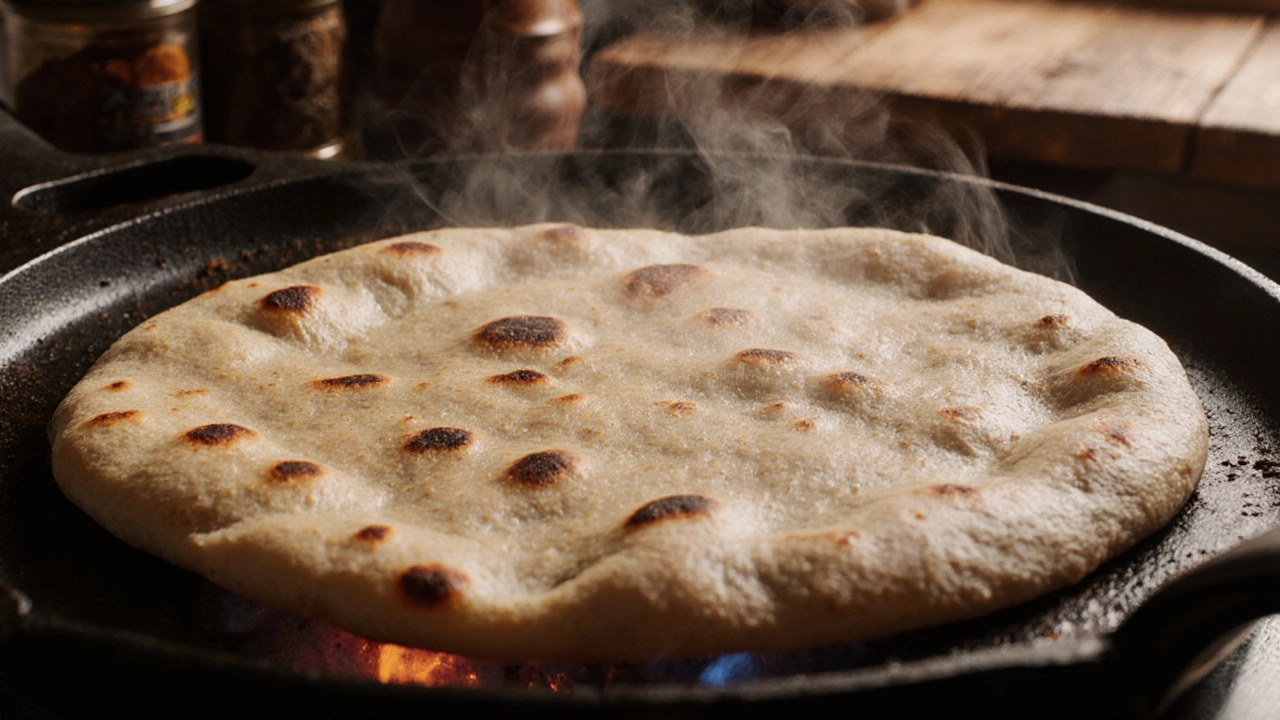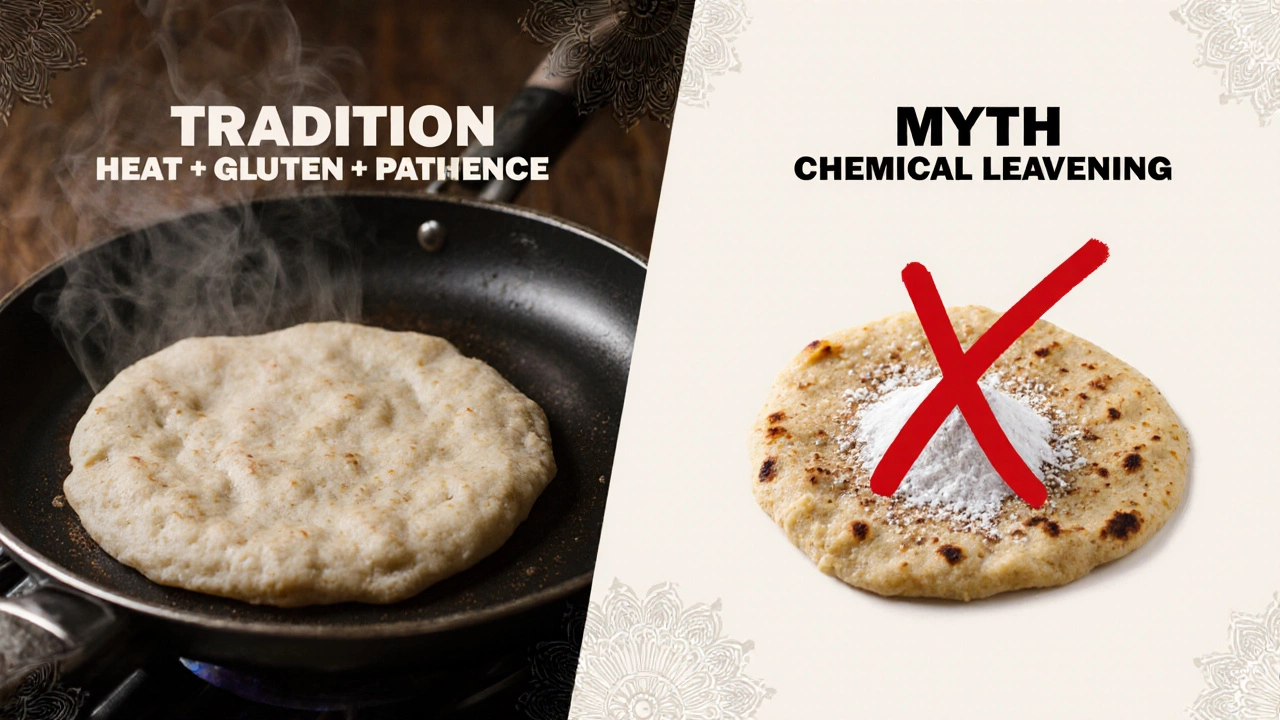Does Roti Need Baking Powder? The Truth Behind Fluffy Flatbreads

Roti Puff Success Calculator
Perfect Puff Predictor
How your preparation affects roti puffing success. Traditional roti doesn't need baking powder - it's all about technique!
Your Roti Puff Potential
Estimated Puff Success
Ever made roti and ended up with a tough, flat disc instead of a soft, pillowy bread? You’re not alone. Many home cooks wonder if adding baking powder will make their roti fluffier. The short answer? No, traditional roti doesn’t need baking powder-and here’s why that’s actually a good thing.
What Makes Roti Roti?
Roti is a simple unleavened flatbread made from just three ingredients: whole wheat flour (atta), water, and salt. That’s it. No yeast, no baking powder, no oil. The magic happens through technique, not chemistry.
Unlike Western breads that rely on leavening agents to rise, roti gets its puff from steam. When you roll out a thin disc and cook it on a hot tawa, the moisture inside turns to steam. That steam pushes the dough apart, creating those beautiful air pockets you love. It’s the same principle as a tortilla puffing up on a griddle-but roti does it better because of the protein content in atta.
Whole wheat atta has more gluten than all-purpose flour. That gluten network traps steam and holds the shape as it expands. Add baking powder, and you’re introducing chemical leavening that doesn’t match the structure of roti. The result? A denser, sometimes metallic-tasting bread with uneven puffing.
Why People Think Baking Powder Helps
The confusion comes from mixing up roti with other Indian breads. Naan, for example, often uses yeast or baking powder. So do parathas when they’re made with a softer, flakier texture. But roti? It’s meant to be simple, quick, and wholesome.
Some cooks swear they added baking powder once and got better results. That’s likely because they also changed something else-like kneading longer, letting the dough rest, or using warmer water. Those changes improve texture. Baking powder? It’s just a red herring.
A 2023 study by the Indian Institute of Food Processing Technology tested 12 variations of roti dough, including ones with 0.5g, 1g, and 2g of baking powder per 100g of flour. The version with no leavening agent scored highest in puffing, texture, and flavor. The baking powder versions had a slightly bitter aftertaste and didn’t puff as consistently.
What Actually Makes Roti Soft and Puffy
If not baking powder, then what? Four things:
- High-quality atta-Look for stone-ground whole wheat flour with a fine texture. Coarse flour won’t form a smooth dough.
- Proper kneading-Knead for at least 8-10 minutes until the dough feels soft and elastic. It should bounce back when you press it.
- Resting the dough-Cover it and let it sit for 20-30 minutes. This lets the gluten relax and the flour hydrate fully. Cold dough won’t puff.
- Hot tawa-Your cooking surface needs to be properly heated. Test it by sprinkling a few drops of water. They should dance and evaporate instantly.
Roll your roti thin-not too thick, not too thin. About 6-7 inches across. Cook on medium-high heat. Flip once you see bubbles forming. Press gently with a spatula when it starts puffing. That’s the steam doing its job.

When Baking Powder Might Be Used (And Why It’s Still Not Roti)
There are exceptions. Some modern recipes, especially those targeting kids or people with chewing difficulties, add a pinch of baking powder to make roti softer. But that’s not traditional roti anymore-it’s a hybrid. Same goes for rotis made with a mix of refined flour (maida) and atta. Those often include baking powder to compensate for the lack of gluten.
If you’re making roti for someone with digestive issues, consider soaking the atta overnight or using fermented dough (like in idli or dosa batter). Those methods improve digestibility without altering the bread’s nature.
Don’t confuse roti with bhatura or puri. Those are deep-fried, leavened breads. They need yeast or baking powder. Roti is grilled. It’s meant to be humble, healthy, and fast.
Common Mistakes That Make Roti Hard
Most hard rotis aren’t caused by missing baking powder-they’re caused by:
- Using cold water to make the dough
- Not kneading enough
- Rolling too thick
- Cooking on a low or uneven heat
- Not pressing the roti gently while it cooks
One woman in Delhi, who’s been making roti for 40 years, told me: “If your roti doesn’t puff, it’s not because you forgot the powder. It’s because you forgot to love the dough.” She’s not being poetic-she’s right. Roti responds to care. It’s a tactile, sensory process. You learn it by feeling the dough, watching the bubbles, listening to the sizzle.

Roti vs. Other Flatbreads: What’s the Difference?
Here’s a quick comparison to clear up confusion:
| Bread | Main Ingredients | Leavening Agent? | Cooking Method | Texture |
|---|---|---|---|---|
| Roti | Atta, water, salt | No | Grilled on tawa | Soft, chewy, puffy |
| Naan | Maida, yogurt, yeast or baking powder | Yes | Baked in tandoor | Cheesy, airy, slightly sweet |
| Paratha | Atta, ghee/oil, salt | No (unless layered) | Fried or grilled | Flaky, layered |
| Puri | Atta or maida, water, salt | Often yes | Deep-fried | Crispy, balloon-like |
| Chapati | Same as roti | No | Grilled on tawa | Identical to roti |
Notice something? Roti and chapati are the same thing. The name changes by region. Neither needs baking powder. Naan and puri do-but they’re not roti.
What to Do If You’ve Already Added Baking Powder
If you accidentally added baking powder to your roti dough, don’t toss it. You can still cook it. But don’t expect perfect puffing. The texture will be a bit spongier, and you might taste a slight metallic note.
For next time, keep baking powder out of your roti dough. Save it for cakes, pancakes, or quick breads. Roti doesn’t need it. It needs patience, practice, and a hot tawa.
Final Tip: The Real Secret to Perfect Roti
It’s not baking powder. It’s not fancy flour. It’s not a fancy tawa.
It’s the heat.
Most people cook roti on medium heat. That’s too low. You need medium-high to high. The dough should sizzle the moment it hits the pan. If it doesn’t, wait longer. Let the tawa get properly hot. That’s when the steam forms fast enough to puff the roti before it dries out.
And if it doesn’t puff? Flip it. Press it. Cook the other side. Sometimes it puffs on the second flip. Don’t give up. Every roti master has made a dozen flat ones before they got it right.